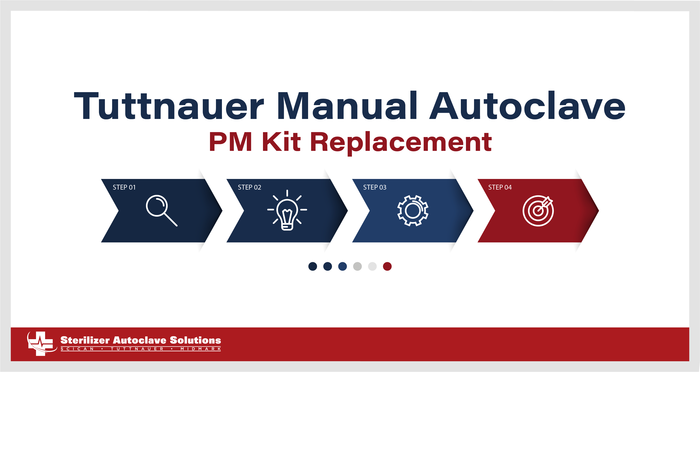Tuttnauer Manual Autoclave PM Kit Replacement
In this article, we’re going to explain what you can find in your Tuttnauer Manual Autoclave Preventative Maintenance Kit. A brief explanation of each part, and how to replace it in minor detail. And of course this guide is complimented by the accompanying video of the same title.
But if you’re more of a visual learner, we have just the video for you here.
And if you just want to talk to someone, call our Free Tech Support at 704-966-1650 Option 3.
What You’ll Need
There are a few tools you’ll need to complete the replacement process of your annual pm kit parts. To begin the process you’ll need the following:
- Phillips Screwdriver
- 5/8 Wrench (This size can be interchangeable depending on the Safety Valve in question.)
- 10 mm Wrench
- Adjustable Wrench
Note: Before starting this process it is very important to remember to unplug your autoclave from both the back of the unit and the wall. And we highly recommend you clean your reservoir beforehand due to how much you’ll be working in it for this specific PM Kit replacement.
The reservoir can be cleaned with OptiClave, which we do carry for you here. You use about 2 ounces in the reservoir the night before you do all this, and let it sit. It’ll eat away at any buildup left in the reservoir and you can rinse it by opening the drain cap and putting water into the reservoir itself to flush it out.
What’s In The Box
Air Jet Valve
The air jet valve is the part that assists in the elimination of air from the sterilization chamber during heat up. A critical move for the autoclave during its cycles. Failure to properly maintain the air jet valve can lead to incomplete sterilization for one. And even indicator strips that do not turn, failed spore tests and aborted sterilization cycles.
The removal of the air jet valve is simple. Take your 10 mm wrench and just unscrew it carefully. Loosen it to a point where it is able to be unscrewed with just your hand and continue that way for ease.
To replace the old with the new, just reverse the process. Hand tighten the new air jet valve to the point where you feel more comfortable using the 10 mm wrench to screw it back in enough. Remember not to over-tighten the air jet, as that will cause problems down the line. You can use Teflon tape if you wish, but due to its messy and unpredictable nature when in the autoclave reservoir, we don’t really recommend that.
The Black Top Air Jet Valve can be purchased here.
The Red Top Air Jet valve is available here.
Safety Valve
The Safety Valve is another very important part of your autoclave. It is a fail-safe device that can be pulled when the electronics in the machine fail during a time when the cycle needs to be aborted. It’s located right inside the reservoir near the air jet valve as well.
To remove the old safety valve, you’ll want to use the adjustable wrench and your 5/8 wrench (or whatever size wrench the safety valve takes.) Ue the adjustable wrench on the part that the valve is screwed into, and use counter pressure with the 5/87 wrench on the valve itself to loosen it. The adjustable wrench should not move at all, the smaller wrench and valve should be doing all the work. Once it’s loose enough you should be able to unscrew it the rest of the way by hand.
The installation of the new one is as simple as the air jet, just reverse the process of taking it out. Screw it in by hand first, then switch to the sized wrench and adjustable wrench and finish the job. Remembering to apply counter-pressure while doing so. Also, remember not to over-crank anything. If the brass fitting on the other side of the valve moves when you twist, you’ve gone too far and need to adjust that accordingly.
The Tuttnauer Safety Valve is available here.
Door Gasket
The door gasket helps seal the autoclave door and prevent steam leaks. It’s always listed as an annual maintenance part, however if you run consecutive or back-to-back cycles it will need to be changed more frequently.
To remove the old door gasket, you’ll just have to carefully pull it out. It’s a rubber gasket so it should come out pretty easily.
To put the new one in, there’s a pattern you’ll want to follow. Think of it like clockwork. Positions that is. When you put the gasket in, start from the top, and push in the bottom next. So start at 12 o’ clock and then push at 6 o’ clock. Once you’ve got the top and bottom pretty much secured, 9 and 3 are next, but there’s no particular order for the left and right sides. So once you’ve secured the main 4 areas, just start pushing in around in the “corners” and work your way around in a sort of wiping motion around until the rest of the gasket is sitting snug within its place. you can readjust any part of the gasket without having to remove the whole thing, so don’t sweat it.
We have Tuttnauer Door Gaskets for purchase here.
Final Thoughts
And that’s it! You’ve successfully completed your annual maintenance on your manual Tuttnauer autoclave. Now your machine is set and ready for the work ahead.
As always if you have any questions about this process or anything else please feel free to contact us and take advantage of our “FREE TECH SUPPORT.”
We also offer FREE VIRTUAL TECH SUPPORT to “See and Talk” with a “Real Time Live Technician” for any problems you may be in need of help with.
You can also use our “FREE MAINTENANCE PROGRAM”. Take the guesswork and worrying about what unit is due for maintenance and which maintenance cycle it is time for. We will keep track of all your autoclaves and let you know when it’s time for anything.


